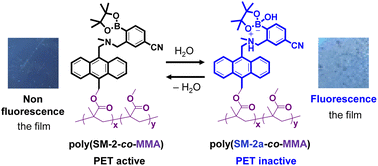Fluorescent polymer films based on photo-induced electron transfer for visualizing water†
Abstract
As fluorescent materials for visualization, detection, and quantification of a trace amount of water, we have designed and developed a PET (photo-induced electron transfer)-type fluorescent monomer SM-2 composed of methyl methacrylate-substituted anthracene fluorophore-(aminomethyl)-4-cyanophenylboronic acid pinacol ester (AminoMeCNPhenylBPin) and achieved preparation of a copolymer poly(SM-2-co-MMA) composed of SM-2 and methyl methacrylate (MMA). Both SM-2 and poly(SM-2-co-MMA) exhibited enhancement of the fluorescence emission with the increase in water content in various solvents (less polar, polar, protic, and aprotic solvents) due to the formation of the PET inactive (fluorescent) species SM-2a and poly(SM-2-co-MMA)a, respectively, by the interaction with water molecules. The detection limit (DL) of poly(SM-2-co-MMA) for water in the low water content region below 1.0 wt% in acetonitrile was 0.066 wt%, indicating that poly(SM-2-co-MMA) can act as a PET-type fluorescent polymeric sensor for a trace amount of water in solvents, although it was inferior to that (0.009 wt%) of SM-2. It was found that spin-coated poly(SM-2-co-MMA) films as well as 15 wt% SM-2-doped polymethyl methacrylate (PMMA) films produced a satisfactory reversible fluorescence off–on switching between the PET active state under a drying process and the PET inactive state upon exposure to moisture, which is demonstrated by the fact that the both the films are similar in hydrophilicity to each other from the measurement of the water contact angles on the polymer film surface. Herein we propose that PET-type fluorescent polymer films based on a fluorescence enhancement system are one of the most promising and convenient functional dye materials for visualizing moisture and water droplets.



 Please wait while we load your content...
Please wait while we load your content...